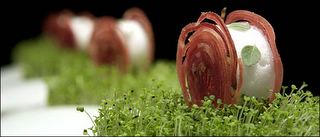'Dogs, Burgers, Wine and Beer...
Hot Dogs and Hamburgers are in the food sections of the New York Times and Boston Globe. In NY, Ed Levine has a look at where you can find the best Hot Dogs in the city, looking at "Katz's Delicatessen, Gray's Papaya, Papaya King, the legendary Dominick's truck in Queens", and of course, Nathan's. He defines what various Hot Dogs terms mean, (A true Kosher dog...etc) and sets down what makes a great hot dog to him:
The Boston Globe has a short primer on building a great hamburger this summer. Here's a few tips from the piece:
Eric Asimov has a look at an Italian winemaker who is trying an unusual fermentation process:
Need some dessert now? Jane Dornbusch has a recipe for bread pudding made with Krispy Kreme Doughnuts.
So what constitutes a great hot dog? To me, it's a grilled, kosher-style frank served on a lightly toasted bun with slightly spicy mustard and a homemade onion or pickle relish that is neither too sweet nor too hot. The Old Town Bar on East 18th Street not only toasts the bun that encases its grilled natural-casing all-beef Sabrett dog, it butters it as well. Sublime! Sauerkraut is also fine atop my dogs, though every once in a while I crave one prepared Southern style, with cole slaw. My ideal dog should fit neatly into its bun, sticking out by at most an inch on each end.He notes that the NY Style Hot Dog has been around for over 100 years, and in some parts of the city, you can pay almost $20 for a "Haut Dog". He also runs down the top places in New Jersey and Connecticut to get your fix. Man, now I'm craving a hot dog...and the gas station ones aren't going to cut it...
The Boston Globe has a short primer on building a great hamburger this summer. Here's a few tips from the piece:
- Use 85 percent lean ground chuck, "lightly" formed into one inch thick patties
- Find one intense topping - sauteed golden mushrooms, a spicy guacamole
- Get the right type of cheese for your burger - Roquefort, Stilton or an aged Gouda can all work
- Choose buns that are dense enough to hold up to the patty's juices.
- You can use the traditional toppings, or try "thinly sliced extra-sweet onions tossed with a little vinegar, chopped tomatoes marinated in oil and balsamic, or even a little slaw."
Eric Asimov has a look at an Italian winemaker who is trying an unusual fermentation process:
Rejecting the modern trappings of the cellar, Mr. Gravner has reached back 5,000 years. He now ferments his wines in huge terra-cotta amphorae that he lines with beeswax and buries in the earth up to their great, gaping lips. Ancient Greeks and Romans would be right at home with him, yet his 2001 wines, his first vintage from the amphorae, which he is planning to release in September, are more vivacious and idiosyncratic than ever.Ann Cortissoz has a look at Samuel Adams founder Jim Koch and how far his brewery has come in 21 years. He offers some pairing suggestions for some of the various brews with food.
Need some dessert now? Jane Dornbusch has a recipe for bread pudding made with Krispy Kreme Doughnuts.


